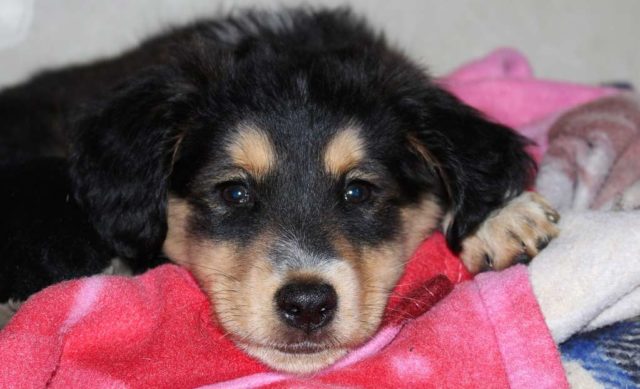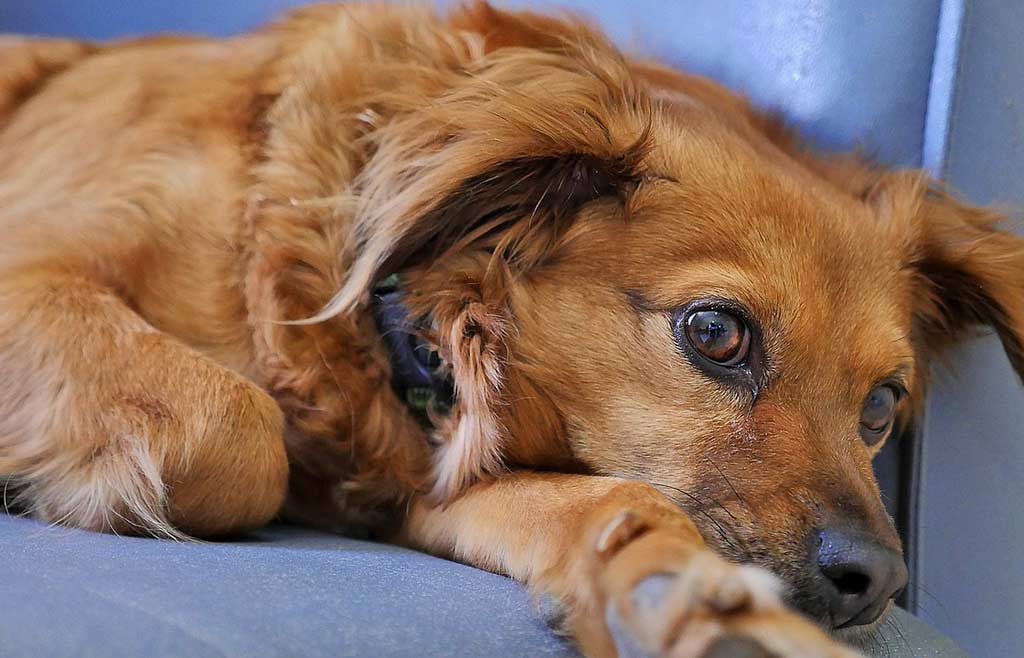
Any kind of illness or virus can be a scary thing to imagine when getting a new puppy. Parvo in puppies is unfortunately a pretty common disease that can have deadly consequences. The last thing we want to hear as new dog owners is a parvo diagnosis.
It is important to learn how dogs get parvo so you know the signs, symptoms and treatments. Being knowledgeable about parvo gives your puppy the best chance of surviving.
How Do Dogs Get Parvo?
The canine parvovirus causes parvo in puppies. CPV is a highly contagious virus that spreads through direct contact with infected people or dogs. It can also be caught by indirect contact with contaminated objects. Since parvo is transmitted via vomit and feces your puppy can be exposed each time he sniffs, licks, or eats infected feces.
Parvo can be indirectly transmitted by a person who has been recently exposed to an infected dog. By touching your puppy a person can spread the virus with their hands, clothing or even shoes. Contaminated objects, like food or water bowls, leashes, toys or collars can also spread CPV.
Since it seems parvo is so easy to catch you may wonder if parvo is airborne. Rest assured CPV is not airborne, but you still need to take care that your puppy does not come into contact with it.
Certain dog breeds are at an increased risk of parvo so take extra precautions if you own or are exposed to these types of dogs.
- Labrador Retrievers
- American Staffordshire Terriers
- English Springer Spaniels
- German Shepherds
- Doberman Pinschers
- Rottweilers
Why Do Puppies Get Parvo?
Unfortunately puppies are the most susceptible to parvo. Typically puppies ages six weeks to six months are most at risk. Since a mother’s immunity pass to their young puppies younger than 6 weeks old retain some of their mother’s antibodies and are thus partially protected from parvo. That is if the mother underwent her full series of parvo vaccinations.
To protect puppies past the initial 6 week grace period they are vaccinated against parvo around 6, 8, and 12 weeks of age. To develop adequate protection puppies should also get a dose of canine parvovirus vaccine between 14 and 16 weeks of age.
Can a Puppy Get Parvo After the First Shot?
Unfortunately parvo is a persistent little bugger thus a puppy is still susceptible to the virus until the full series of shots is taken. As a new puppy owner you should take extra precaution during the vaccination series to prevent your puppy from getting the virus.
It is also advised you should not allow your puppy to come into contact with unvaccinated dogs until all parvo vaccines have been received. It goes without saying you should make sure all dogs in your household are vaccinated, and be careful when socializing your puppy.
It’s a good idea to socialize your puppy in a more controlled environment where you know the vaccination history of all dogs she comes into contact with.
Dog parks are a potential source of parvo so it is a good idea to avoid them until your CPV series is complete.
Can a Vaccinated Dog Get Parvo?
While the parvo vaccine reduces the rate at which dogs get the disease it is still possible to contract it even if your dog has been vaccinated. Viruses tend to mutate creating slightly different strains thus the vaccine may not protect against all strains of parvo your dog comes into contact with.
Generally though, you can safely socialize your puppy with adult dogs that have been fully vaccinated. Dogs that recover from parvo are usually immune to further cases unless it is from a wildly different strain.
As with any vaccine there are some owners that choose to vaccinate and others who do not. It will always be a raging debate so you will have to determine what is right for your dog.
Puppy classes, doggy daycare centers and boarders, usually require proof of vaccination, but it is still a good idea to speak with your vet about taking precautions when dealing with parvo.
Symptoms of Parvo in Puppies
Puppies with parvo can become very sick. Parvo primarily attacks the stomach and small intestines. It can also affect the bone marrow, lymphopoietic tissues, and heart. Once inside the small intestine the virus destroys cells, impairs absorption, and disrupts the gut barrier.
Signs Your Puppy Might Have Parvo
Early signs include:
- Lethargy
- Depression
- Fever
- Anorexia
- Weakness
- Weight loss
- Dehydration
After a couple days symptoms may progress to:
- Bloody diarrhea
- Severe abdominal pain
- Vomiting
- Shock
- Death
All these symptoms can be serious in and of themselves and may be a sign of serious illness including parvo. Contact your vet immediately if you suspect your puppy has parvo. If you suspect parvo in your puppy notify the vet ahead of time with your puppy’s symptoms as they may need to take appropriate quarantine procedures to prevent other dogs from getting infected.
The sooner you recognize the early signs of parvo in puppies, the sooner you can get your dog to the vet. Of course calling the vet at the first sign of a sick puppy is a good idea, but being aware of the specific symptoms of parvo in puppies will help initiate a fast recovery.
Parvo severity varies. Stress weakens the immune system. Weaning, crate training, social interaction with other puppies and other forms of stress can lead to a more severe case of parvo in puppies. Also a secondary infection or parasite in conjunction with parvo can also lead to more severe cases.
How Long Does Parvo Last in a Puppy?
Puppies and adult dogs with parvo start shedding the virus within 4 to 5 days of exposure. Unfortunately this time period does not always coincide with the first signs of symptoms. Thus dogs can be contagious before you even realize they are sick. Furthermore puppies with parvo shed the virus for up to 10 days after recovering. It is a good idea to keep puppies recovering from parvo away from unvaccinated and partially vaccinated dogs.
The parvo virus can survive on objects indoors for at least a month, and outdoors it can survive for even longer; many months to a year under the right conditions.
The best way to remove the parvovirus from your home, kennel and toys is to disinfect the objects with a solution of two parts bleach to one part warm water. Any fabrics and clothes should be washed with added bleach to the warm wash cycle. Remove any feces from the premises as well.
How to Treat Parvo
When you bring your dog to the vet she will diagnose parvo based on the clinical signs mentioned above and through blood work. A test called an ELISA may be used to search for virus antigens in your dog’s feces. Additional diagnostic testing may be performed as needed.
There is no known cure for parvo. As with most viruses your dog’s immune system does the heavy lifting and must overcome the virus by itself. Your vet can give your puppy supportive care during the illness to treat symptoms.
Care can be given to help vomiting, diarrhea, dehydration and other signs of discomfort. Making sure your puppy gets adequate nutrition is also important.
Parvo also weakens a puppy’s immune system and lowers his white blood cell count. This decreases his ability to fight off secondary bacterial infections.
Since parvo damages the intestinal wall it increases the likelihood of a secondary infection. Your vet may put use an antibiotic medication to fight these bacterial infections.
Canine Parvovirus Survival Rate
Parvo is a potentially fatal disease. The survival rate of dogs treated by a veterinarian is 68 to 92 percent. Untreated the virus has up to a 90% fatality rate. Most puppies that survive the first 3-4 days make a complete recovery however. Recovery times vary depending on the severity of the case, but recovery time usually takes about one week.
Your veterinarian can discuss with you appropriate treatment steps for your puppy’s specific case. He can also advise you on other precautionary steps you need to take for any other dogs or puppies in your household.
How to Prevent Parvo
The good news is that parvo is a preventable virus. The best way to prevent parvo is through a full series of vaccinations. It is particularly important that your female dogs receive a full course of parvo vaccinations if you plan on breeding them since puppies depend on the mother’s antibodies for the first few weeks of life.
Parvo is a serious and very contagious disease, but understanding how dogs get parvo, how it spreads, its symptoms, treatment options, and the best ways to prevent parvo in puppies helps you keep your puppy safe.
Note: This article is for informational purposes only. It is not intended as a substitute for veterinary care. If you suspect your dog has parvo, contact your veterinarian right away.









